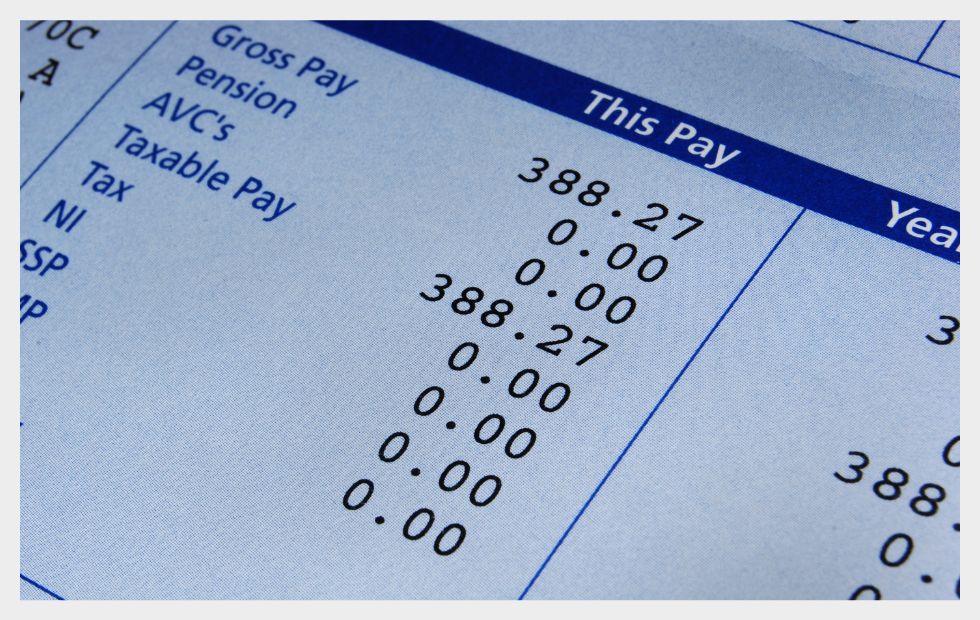¿Cómo funcionan las nóminas en Estados Unidos?

Desglose de una nómina estadounidense: Salario bruto, deducciones e ingresos netos explicados.
Cuando vea su nómina por primera vez, puede resultar un poco abrumador. Pero si se toma el tiempo necesario para aprender cómo funcionan las nóminas, cada parte tendrá sentido.
En su primer cheque de pago, verá una cantidad en dólares llamada «salario bruto», que es el dinero que ha ganado antes de que se eliminara cualquier deducción. Después de esto, observará una cantidad en dólares llamada «salario neto», que también puede llamarse su «sueldo neto». Como su nombre indica, se trata del dinero que puede quedarse para usted.
Quizá se pregunte: «¿Cuál es la diferencia entre salario bruto y salario neto?» o «¿Qué es una deducción?». Estas preguntas son normales, sobre todo si acaba de iniciar su andadura en el mundo laboral estadounidense.
Tanto si recibe su nómina en papel o como un depósito electrónico, también incluirá una sección conocida como «talón de pago». Cuando mire su talón de pago, verá varias secciones con títulos como «ganancias», «salario bruto» e «ingresos netos», y luego otra sección llamada «deducciones», con subsecciones como «impuesto federal sobre la renta», «impuesto de la seguridad social» y «Medicare».
Aunque estos términos puedan parecer confusos, las diferentes partes de su nómina tendrán sentido después de que aprenda lo que significan. En este artículo, examinaremos las partes más comunes de la nómina estadounidense.
En esta guía responderemos a las siguientes preguntas:
¿Qué es la renta bruta?
Cuando escuche el término «ingresos brutos», puede tener dos significados posibles.
El primer significado se refiere a las ganancias totales que un individuo recibe de cualquier fuente de ingresos en su vida. Estas fuentes de ingresos pueden significar cualquier dinero relacionado con el trabajo o dinero que alguien pueda recibir de una propiedad en alquiler, fondos de pensiones, inversiones y más.
El segundo significado de «ingresos brutos» es el que puede oír en una conversación informal en el trabajo. En esta situación, la gente probablemente esté hablando del dinero que gana específicamente por su trabajo antes de que se deduzcan de su nómina las deducciones por impuestos o asistencia sanitaria.

Los ingresos brutos son las ganancias totales antes de impuestos y deducciones, incluidos el salario, las primas y otras compensaciones.
Aquí hablaremos específicamente de los ingresos brutos, ya que están relacionados con su sueldo del trabajo. Generalmente, se utilizan dos métodos diferentes para determinar cuánto dinero recibirán los empleados: el salario y el salario por hora.
¿Qué es el pago por hora?
Determinar un salario por hora es un método común utilizado por las empresas y organizaciones para compensar a los empleados por su trabajo. Esta tarifa por hora suele decidirse antes de que alguien comience un nuevo trabajo y esa tarifa se escribe en un contrato de trabajo.
Esto significa que cada hora que trabaja un empleado, recibe una cantidad de dinero predeterminada. Así, si un empleado gana 20 dólares cada hora y trabaja ocho horas en un día, sus ingresos brutos de ese día serán de 160 dólares. Si ese empleado trabajara una semana laboral normal de 40 horas, sus ingresos brutos serían de 800 $.
Es importante tener en cuenta que cada estado exige a los empleadores que paguen al menos una cantidad mínima de dinero por hora, lo que se conoce como «salario mínimo».
¿Qué es el salario mínimo?
El salario mínimo es la tarifa salarial por hora más baja que los empleadores están legalmente obligados a pagar a sus empleados por ley federal o estatal. El salario mínimo federal, fijado actualmente en 7,25 dólares por hora, sirve como norma de referencia en todo Estados Unidos.
Después de eso, cada estado tiene la autoridad de elegir fijar un salario mínimo más alto si lo considera necesario para adaptarse mejor a sus condiciones económicas y niveles de vida locales.
Por ejemplo, el estado de Nueva York ha fijado su salario mínimo en 15 dólares la hora, lo que refleja su mayor coste de la vida y sus circunstancias económicas. Por el contrario, Florida tiene un salario mínimo de 12 dólares la hora, lo que refleja su coste de la vida relativamente más bajo.
¿Qué es el pago asalariado?
Cuando busque un nuevo empleo, es posible que le ofrezcan una estructura de remuneración basada en el salario en lugar del pago por horas. Es más probable que le ofrezcan un salario las empresas corporativas, las organizaciones sin ánimo de lucro, las organizaciones sanitarias y las agencias gubernamentales.
En los puestos asalariados, normalmente se espera que los empleados completen su trabajo sin importar cuántas horas trabajen. Esto puede parecer extraño porque puede haber ocasiones en las que un empleado trabaje más de 40 horas pero gane la misma cantidad de dinero. Sin embargo, los puestos asalariados suelen ofrecer una estabilidad adicional gracias a prestaciones como tiempo libre remunerado, seguro médico y prestaciones de jubilación.
Un salario representa una cantidad predeterminada y fija de compensación que un empleado recibe de su empleador a lo largo de un año a cambio de sus servicios. Aunque esta compensación suele distribuirse de forma regular, como mensual o quincenalmente, a menudo se establece y discute en términos de una suma anual. Por ejemplo, a un individuo se le puede ofrecer un salario de 70.000 dólares al año.
La cantidad concreta de salario que gana una persona suele estar influida por varios factores, como las políticas del empleador, el nivel de experiencia y conocimientos del empleado, los estándares comunes de la industria y el coste de la vida en un lugar geográfico concreto.
¿Qué es una compensación adicional?
A veces hay adiciones al nivel de salario base que una persona recibe por su trabajo.Las adiciones más comunes al salario base incluyen el pago de horas extras, bonificaciones y comisiones. Estas adiciones están diseñadas para compensar a los empleados por circunstancias excepcionales, rendimiento o para proporcionar incentivos por alcanzar objetivos específicos.

Compensación adicional: Pago extra por horas extraordinarias, primas e incentivos.
¿Qué es el pago de horas extraordinarias?
El pago de horas extraordinarias es una compensación adicional por las horas que un empleado trabaja más allá de la semana laboral estándar. En Estados Unidos, una semana laboral típica suele definirse como 40 horas. La Ley de Normas Laborales Justas (FLSA) de Estados Unidos establece que las personas con derecho a percibir horas extraordinarias deben recibir al menos una vez y media su salario por hora normal por las horas extraordinarias.
Por ejemplo, si la tarifa regular por hora de un empleado es de 20 $, su tarifa por horas extraordinarias sería de 30 $ por hora. Esto se calcula sumando una vez y media la tarifa regular, que es de 20 $ más 10 $ adicionales, ya que 10 $ son la mitad de 20 $. Por lo tanto, la tarifa total por horas extraordinarias es de 30 $. Si un empleado ya ha trabajado 40 horas en una semana y empieza a trabajar 41 horas o más, recibirá 30 $ por hora por cada hora adicional por encima de las 40.
Las horas extraordinarias están diseñadas para compensar a los empleados por periodos de trabajo prolongados, reconociendo el esfuerzo extra y el tiempo dedicado más allá de las horas normales de trabajo.
¿Qué es una prima?
Las primas son un pago adicional que se da a los empleados como recompensa por su rendimiento, su contribución a la consecución de los objetivos de la empresa o para ocasiones especiales.
Un tipo común de bonificación es la de retención, que anima a los empleados a permanecer en la empresa durante un tiempo determinado. Alternativamente, las bonificaciones pueden estar vinculadas a métricas u objetivos de rendimiento específicos establecidos por el empleador. Éstas recompensan a los empleados por alcanzar objetivos como cuotas de ventas, hitos de proyectos o índices de satisfacción de los clientes.
Es posible que también oiga hablar de las bonificaciones de fin de año, que suelen concederse a los empleados cuando el año natural o fiscal se acerca a su fin. Estas bonificaciones suelen estar influidas por factores como el rendimiento de la empresa y el rendimiento individual, así como la antigüedad.
A diferencia del pago de las horas extraordinarias, las primas no forman parte de la estructura salarial que supervisa el gobierno. En su lugar, las primas son una herramienta utilizada para animar y recompensar a los empleados por sus contribuciones al éxito de la empresa.
¿Qué es una comisión?
Las comisiones son una forma de pago de incentivos vinculada a las ventas o al rendimiento de un empleado. Se trata de una práctica habitual en los puestos orientados a las ventas, en los que los empleados reciben un porcentaje de las ventas que generan como parte de su remuneración.
Por ejemplo, un vendedor puede ganar una comisión del 5% por todas las ventas que cierre. Para ilustrarlo, si un vendedor vende un frigorífico de lujo con un precio de 2.000 dólares, ganará una comisión de 100 dólares por esta única venta, calculada como el 5% del precio de venta. Algunos ejemplos comunes de carreras que utilizan la comisión como parte de su estructura salarial son los agentes inmobiliarios, los vendedores de coches y los asesores financieros.
Las estructuras de las comisiones pueden variar mucho, desde tarifas fijas hasta escalas móviles basadas en los niveles de rendimiento. Las comisiones motivan a los empleados a rendir a niveles más altos al vincular directamente la remuneración a su éxito en la generación de ingresos o la consecución de objetivos específicos.
¿Qué son las deducciones?
En el contexto de una nómina, las deducciones significan el dinero que se le retira antes de recibir su paga. Estas deducciones suelen ser para cosas como los impuestos, los seguros, las cotizaciones a la jubilación o los programas públicos de asistencia sanitaria. Las deducciones se restan de su salario bruto y la cantidad sobrante es el salario neto.

Comprender las retenciones en la nómina: Impuestos, seguros y otras retenciones.
Veamos algunas de las deducciones más comunes en EE.UU.
¿Qué es el impuesto federal sobre la renta?
El impuesto federal sobre la renta es un porcentaje de los ingresos de un individuo exigido por el gobierno federal, cuya cuantía específica viene determinada por el nivel de ingresos y el tramo impositivo del empleado.
En Estados Unidos, el impuesto sobre la renta funciona según un sistema progresivo, lo que significa que las diferentes porciones de ingresos se gravan a tipos diferentes dentro de unos rangos de ingresos específicos, conocidos como tramos impositivos.
Tomemos el ejemplo de una persona soltera sin personas a su cargo que ganara 70.000 dólares en el año 2023. Si esa persona aceptara la deducción estándar del gobierno de EE.UU. de 12.550 $, sólo tributaría por los 57.450 $ restantes de sus ingresos.
| Escala impositiva | Ingresos dentro de la horquilla | Ingresos multiplicados por porcentaje | Total |
| 10% | De 0 a 11.000 dólares | $11,000 x 10% | $1,100 |
| 12% | De $11.001 a $44.725 | $33,724 x 12% | $4,047 |
| 22% | De 44.726 a 95.375 dólares | $12,725 x 22% | $2,799 |
| Total final: $7.946 |
Así, alguien que gane un salario de 70.000 dólares en un año, puede esperar pagar entre 7.000 y 8.000 dólares en impuestos federales.
¿Qué es el impuesto estatal sobre la renta?
El impuesto estatal sobre la renta es el dinero que la gente paga al gobierno de su estado en función del dinero que gana. Cada estado establece sus propias normas y tipos para determinar cuántos impuestos debe pagar la gente. Algunos estados no tienen impuesto estatal sobre la renta, como Florida, Texas y Washington.
Cuando usted trabaja y gana dinero en un estado, una parte de ese dinero va al gobierno estatal en concepto de impuestos. La cantidad de impuestos que debe depende de cuánto dinero gane y de las normas de su estado.
¿Qué es la Seguridad Social?
Otra deducción que verá en su recibo de sueldo es la Seguridad Social, que es un programa social creado por la FICA (Ley Federal de Contribuciones al Seguro).
Cada periodo de pago, a los trabajadores se les retiene el 6,2% de sus ingresos brutos para la Seguridad Social. Esta retención forma parte del programa del gobierno para financiar prestaciones futuras como la jubilación, la invalidez y la ayuda a los supervivientes. La cuantía de los ingresos sujetos a este impuesto tiene un tope anual, lo que significa que existe un límite máximo de lo que puede gravarse a efectos de la Seguridad Social cada año.
¿Qué es Medicare?
Medicare, como parte de las deducciones de las nóminas en virtud de los impuestos FICA, representa un programa de seguro de enfermedad principalmente para las personas de 65 años o más, pero también para algunas personas más jóvenes con discapacidades.
En las nóminas, los asalariados contribuyen con el 1,45% de sus ingresos brutos a Medicare, sin límite máximo. Esta cotización ayuda a financiar los costes del programa Medicare, garantizando que pueda proporcionar prestaciones médicas a los beneficiarios que cumplan los requisitos.
¿Hay otras deducciones de mi nómina?
Además de las deducciones obligatorias que pueden realizar el Estado y el gobierno, a veces existen deducciones opcionales de su salario bruto. Los tipos más comunes de deducciones opcionales que verá en Estados Unidos son para las primas del seguro médico, las contribuciones al plan de jubilación y las cuotas sindicales.

¿Adónde va su nómina? Explorando deducciones opcionales como 401(k), Roth IRA y cuotas sindicales.
¿Qué son las primas del seguro de enfermedad?
Muchas empresas ofrecen un seguro médico a sus empleados como parte de su paquete de prestaciones.
Este seguro ayuda a cubrir los costes de la atención médica, como las visitas al médico y los medicamentos recetados. Cuando se inscribe en un seguro médico a través de su trabajo, es posible que tenga que pagar una parte del coste, que se denomina prima.
Su empresario puede descontar esta prima de su nómina antes de que usted cobre. La cantidad que le descuenten puede depender del tipo de seguro médico que elija y de cuánto decida contribuir su empresa al coste. Así que cuando mire su recibo de sueldo, probablemente verá algo como «seguro de enfermedad». Su recibo de sueldo puede incluso incluir el nombre del proveedor de asistencia sanitaria, como «Mayo Health», o «Kaiser Permanente».
Normalmente, tendrá la opción de elegir entre una gama de planes de asistencia sanitaria. Los planes de asistencia sanitaria más caros pagarán los problemas de salud más caros, mientras que los planes menos caros cubrirán menos problemas. Dependiendo del plan que elija, puede esperar pagar entre 100 y 500 dólares cada mes.
¿Cómo se descuentan de mi nómina las cotizaciones para la jubilación?
Existen 3 tipos principales de cuentas de jubilación en EE.UU.; 401(k), Roth IRA y 403(b). Estas cuentas ayudan a las personas a ahorrar dinero para su futuro después de dejar de trabajar. Cada cuenta tributa de forma un poco diferente.
-
¿Qué es un 401(k)?
Lo ofrecen muchos empleadores y permite a los empleados ahorrar dinero de sus nóminas antes de deducir los impuestos. Esto significa que el dinero que ingresa en un 401(k) no se grava inmediatamente, lo que puede reducir su renta imponible del año. Sin embargo, cuando retire el dinero de su 401(k) durante la jubilación, tendrá que pagar impuestos sobre él en función de su tipo impositivo sobre la renta en ese momento. Puede que aparezca etiquetado como «deducción 401(k)» o algo similar en su recibo de nómina.
-
¿Qué es un 403(b)?
Es similar a un 401(k), pero suelen ofrecerlo ciertos empleadores como las escuelas públicas, los hospitales y las organizaciones sin ánimo de lucro. Con un 403(b), también puede ahorrar dinero de su nómina antes de que se le descuenten los impuestos, al igual que con un 401(k). Puede que aparezca etiquetado como «contribución 403(b)» o algo similar en su recibo de nómina.
-
¿Qué es una cuenta IRA Roth?
Se trata de una cuenta de jubilación individual que usted abre por su cuenta en una entidad financiera. Con una cuenta Roth IRA, usted aporta dinero que ya ha tributado de su nómina y no lo verá en su recibo de sueldo.
¿Cómo se descuentan las cuotas sindicales de mi nómina?
Un sindicato es una organización formada por trabajadores para representar colectivamente sus intereses en el lugar de trabajo. El sindicato pretende mejorar los salarios, las prestaciones, las condiciones de trabajo y la seguridad laboral general de los empleados. Las «cuotas sindicales» son las cuotas que los miembros de un sindicato pagan para apoyar las actividades del sindicato, como la negociación colectiva, la defensa y los servicios a los miembros. Generalmente se cobran de cada nómina.
En su nómina, las cuotas sindicales aparecerán normalmente como una deducción o retención. La redacción exacta o la etiqueta utilizada para describir las cuotas sindicales puede cambiar en función de su trabajo y del sistema de nóminas específico que utilicen. Sin embargo, es habitual ver una partida en su recibo de nómina que indica la cantidad de dinero deducida en concepto de cuotas sindicales. Por ejemplo, en su recibo de nómina, puede ver una línea etiquetada como «Cuota sindical» o «Cuota de afiliación sindical», seguida de la cantidad deducida de su salario bruto.
Las cuotas sindicales suelen calcularse como un pequeño porcentaje de su salario, normalmente en torno al 1% o 2% de sus ingresos. Por ejemplo, si gana 1.000 dólares, su recibo de sueldo mostrará normalmente que ha pagado 10 ó 20 dólares en concepto de cuotas sindicales.
¿Qué es el salario neto?

Comprender el salario neto: El dinero que se queda después de aplicar todas las deducciones.
Ahora que hemos cubierto el salario bruto y las deducciones, vamos a ver el dinero que realmente se lleva a casa.
«Salario neto» se refiere a la cantidad de dinero que un empleado recibe en su nómina después de que todas las deducciones, como impuestos, primas de seguros, cotizaciones a la jubilación y cualquier otra retención, se hayan restado de sus ingresos brutos.
En términos sencillos, el salario neto es el salario neto real que recibe un empleado, que representa el dinero que tiene disponible para gastar o ahorrar después de contabilizar todas las deducciones de sus ingresos. Esencialmente, el salario neto es lo que queda después de restar de los ingresos brutos todas las deducciones obligatorias y voluntarias de las que hemos hablado anteriormente.
¿Cuál es la diferencia entre salario bruto y salario neto?
«Salario bruto» se refiere a la cantidad total de dinero ganado antes de las deducciones. Esta cifra muestra cuánto dinero ganaría si no se dedujeran impuestos ni deducciones de sus ingresos.
Por otro lado, el «salario neto» es la cantidad real recibida en una nómina una vez restadas las deducciones como los impuestos y las primas de seguros. El salario neto es la cantidad de dinero que puede ahorrar, gastar o invertir a su antojo.
¿Cómo funcionan los periodos y las fechas de pago?
Un periodo de pago es el periodo de tiempo específico durante el cual un empleado trabaja y percibe un salario. Por ejemplo, puede ser una semana, dos semanas, un mes. Cuando consulte su nómina, el dinero que gane se limitará normalmente a ese periodo de pago. Uno de los periodos de pago más comunes es de dos semanas. Es decir, recibirá dinero por las horas trabajadas en un periodo de 14 días.

Los periodos de pago determinan cuándo le pagan, mientras que las fechas de pago marcan el día en que le llegan sus ganancias.
La fecha de pago es el día en el que un empleado recibe el pago por el trabajo realizado durante ese periodo de pago. Las fechas de pago suelen seguir al final de un periodo de pago unos días para permitir el procesamiento de las nóminas. A veces, oirá llamar «día de paga» a la fecha de pago.
¿Cómo funcionan los periodos de pago para los puestos asalariados?
Para los puestos asalariados, los ingresos brutos suelen estar determinados por el salario anual acordado en el contrato de trabajo.
Para calcular los ingresos brutos de un puesto asalariado sobre una base semanal, quincenal o mensual, divida el salario anual por el número correspondiente de semanas, quincenas o meses de un año.
Por ejemplo, si alguien tiene un salario anual de 70.000 $, sus ingresos brutos por un periodo de pago semanal serían 70.000 $ divididos por 52, que es el número de semanas de un año. Esto daría como resultado aproximadamente 1.346,15 $ cada semana.
Para un periodo de pago «bisemanal», es decir, cada dos semanas, los ingresos brutos de un empleado de 70.000 $ se dividirían entre 26 porque ese es el número de periodos bisemanales que hay en un año. Esto daría como resultado aproximadamente 2.692,31 dólares cada dos semanas.
Por último, para un periodo de pago mensual, los ingresos brutos serían 70.000 $ divididos por 12, que es el número de meses de un año. Esto daría como resultado aproximadamente 5.833,33 $ cada mes.
¿Cómo funcionan los periodos de pago para los empleados por horas?
Los periodos de pago para los empleados por horas suelen implicar el registro de las horas trabajadas dentro de un marco temporal específico, como una semana, dos semanas o un mes.
Al final de cada periodo, el empresario calcula el total de horas trabajadas por el empleado y lo multiplica por su salario por hora para hallar sus ingresos brutos. La frecuencia de los periodos de pago puede variar en función de las políticas del empleador. Los periodos más habituales son el semanal, el quincenal (cada dos semanas) y el mensual.
Por ejemplo, consideremos a un empleado que trabaja 40 horas semanales a razón de 20 dólares por hora.
-
En un periodo de pago semanal, sus ingresos brutos serían de 20 $/hora × 40 horas = 800 $.
-
En un periodo de pago bisemanal, los ingresos brutos serían de 20 $/hora × 40 horas × 2 semanas = 1.600 $.
-
En un periodo de pago mensual, sus ingresos brutos serían de 20 $/hora × 40 horas × 4 semanas = 3.200 $.
Los empleados por horas suelen utilizar tarjetas de tiempo o sistemas digitales para hacer un seguimiento de sus horas trabajadas, asegurándose de que se les paga con exactitud y a tiempo. Por ejemplo, podría trabajar para una empresa que le pide que escanee su huella dactilar o su tarjeta de control horario al empezar y terminar su jornada laboral. También podría trabajar para una empresa que le pida que introduzca un código personal al principio y al final de cada jornada laboral.
Como empleado, es una buena idea que lleve personalmente un registro de las horas que trabaja. Esto se debe a que a veces su lugar de trabajo puede cometer un error al calcular sus horas. Al llevar un registro, puede comparar su información personal con las horas que su trabajo dice que ha trabajado.
¿Cómo funcionan las nóminas para los trabajadores no ciudadanos?
Los trabajadores extranjeros en Estados Unidos deben tener en cuenta varios factores importantes, como el tipo de visado, el tiempo que pueden trabajar y los beneficios de los convenios fiscales.
El tipo de visado que posea un no ciudadano afecta a su trabajo y a cómo se le paga. Los visados más comunes son el visado H-1B para trabajadores cualificados, el visado J-1 para visitantes de intercambio y el visado F-1 para estudiantes.

Las nóminas de los trabajadores no ciudadanos dependen del tipo de visado, de las normas fiscales y de la elegibilidad para el empleo en EE.UU.
¿Cómo es la nómina de los titulares de un visado H-1B?
Los visados H-1B permiten a los trabajadores cualificados trabajar en Estados Unidos durante un máximo de seis años. Sin embargo, las prórrogas más allá de los seis años pueden ser posibles en determinadas circunstancias, como si la persona está en proceso de solicitar una tarjeta verde.
En las nóminas de los titulares de visados H-1B puede constar su derecho a trabajar a tiempo completo en Estados Unidos. A los titulares de un visado H-1B se les suele pagar de acuerdo con las condiciones de su contrato de trabajo, de forma similar a como se paga a los ciudadanos estadounidenses o a los residentes permanentes.
Sus talones de pago pueden incluir detalles como los ingresos brutos, deducciones como impuestos, primas de seguros y salario neto, similares a los de los trabajadores ciudadanos en EE.UU. Normalmente, los titulares de visados H-1B deben pagar a programas FICA como la Seguridad Social y Medicare.
¿Cómo es la nómina de los titulares de un visado J-1?
La duración de la autorización de trabajo para los titulares de un visado J-1 viene determinada por los términos descritos en su formulario DS-2019, que emite el patrocinador de su programa. Los visitantes de intercambio suelen estar autorizados a trabajar durante la duración de su programa, que puede oscilar entre unas semanas y varios años.
Algunos empleos comunes que pueden tener los titulares de un visado J-1 son becarios de investigación, profesores, au pairs, consejeros de campamentos y médicos que participan en programas de formación clínica.
En general, los titulares de visados J-1 considerados extranjeros no residentes a efectos fiscales pueden estar exentos de pagar impuestos de Seguridad Social y Medicare sobre los ingresos obtenidos por un empleo en Estados Unidos. Sin embargo, esta exención suele aplicarse si el empleo está directamente relacionado con su programa J-1, como el empleo en el campus o el empleo autorizado en virtud de una categoría específica del programa de visitantes de intercambio.
Sin embargo, si el titular de un visado J-1 se convierte en extranjero residente a efectos fiscales en virtud de la prueba de presencia sustancial, puede quedar sujeto a los impuestos FICA sobre sus ingresos mientras dure su estancia en Estados Unidos.
¿Cómo es la nómina de los titulares de un visado F-1?
Los titulares de un visado F-1 que son estudiantes internacionales que estudian en Estados Unidos tienen una autorización de trabajo limitada. Normalmente se les permite trabajar en el campus a tiempo parcial durante el año académico y a tiempo completo durante las pausas oficiales de la escuela, como las vacaciones de verano.
En determinadas circunstancias, los estudiantes F-1 también pueden optar a una autorización de empleo fuera del campus a través de los programas de Formación Práctica Curricular (CPT) o Formación Práctica Opcional (OPT), que les permiten adquirir experiencia laboral directamente relacionada con su campo de estudio.
Sin embargo, la duración total del empleo bajo OPT no puede exceder los 12 meses por nivel de titulación, y se aplican reglas adicionales para los estudiantes STEM (Ciencia, Tecnología, Ingeniería y Matemáticas) que pueden ser elegibles para una extensión adicional de 24 meses de OPT STEM.
Las nóminas de los titulares de un visado F-1 se ven influidas por su autorización limitada de trabajo y por cualquier condición vinculada a su estatus de visado. Por ejemplo, los estudiantes F-1 pueden estar restringidos a un empleo a tiempo parcial en el campus durante el año académico.
Generalmente, los titulares de visados F-1 que son extranjeros no residentes a efectos fiscales están exentos de pagar impuestos de Seguridad Social y Medicare sobre los salarios obtenidos por un empleo en Estados Unidos. Esta exención se aplica a los ingresos obtenidos por un empleo autorizado en el campus, un empleo fuera del campus autorizado en virtud de la Formación Práctica Curricular (CPT) o la Formación Práctica Opcional (OPT) y otros tipos de empleo permitidos en circunstancias específicas.
Sin embargo, si el titular de un visado F-1 se convierte en extranjero residente a efectos fiscales en virtud de la prueba de presencia sustancial, puede quedar sujeto a los impuestos FICA sobre sus ingresos mientras dure su estancia en Estados Unidos.
¿Qué es un beneficio de un tratado fiscal?
Los trabajadores no ciudadanos pueden beneficiarse de los tratados fiscales entre sus países de origen y Estados Unidos. Estados Unidos tiene estos tratados con muchos países, como el Reino Unido, India y China.
Un tratado fiscal está diseñado para evitar la doble imposición de una persona que obtiene ingresos en un país mientras vive en otro. Los beneficios de los tratados fiscales pueden adoptar diversas formas, como tipos impositivos más bajos para determinados tipos de ingresos, exenciones de impuestos en determinadas condiciones, créditos fiscales por los impuestos pagados al otro país y un trato especial para determinados grupos como estudiantes o profesores.
Estos tratados tienen normas especiales sobre cómo se grava a los no ciudadanos por el dinero que ganan. Por ejemplo, algunos tratados permiten a los no ciudadanos evitar los impuestos sobre cierto dinero si cumplen condiciones específicas, como pasar poco tiempo en el país o ganar menos de una cantidad determinada.
Cada país tiene normas diferentes en lo que respecta a los convenios fiscales, por lo que los trabajadores extranjeros deben asesorarse con expertos jurídicos y fiscales.
Conclusión
Las nóminas y los recibos de sueldo pueden parecer abrumadores, pero es importante examinar detalladamente cada parte. Esto evita que se sienta sorprendido y le permite asegurarse de que le están pagando la cantidad adecuada. Comprender su nómina y su recibo de sueldo también le permitirá saber qué puede esperar en términos de impuestos, jubilación y asistencia sanitaria.
A medida que siga trabajando, puede ser una buena idea guardar sus propios registros de sus nóminas y talones de pago en un ordenador o en un disco duro externo. Puede ser una buena herramienta para volver a comprobar sus finanzas en el futuro.
Después de conseguir su primer empleo, es posible que empiece a notar que la cultura laboral en Estados Unidos es diferente a la de su país de origen.
Como en cualquier país, a veces puede haber normas y formalidades tácitas que otras personas parecen conocer ya. Esto puede afectar a su vida laboral a medida que avanza, especialmente si está pensando en pedir un aumento de sueldo por hora o negociar un nuevo salario.
En nuestro próximo debate echaremos un vistazo a la cultura laboral en EE.UU. y cómo puede influir en la cantidad de dinero que usted gana. También echaremos un vistazo a algunas cosas que podría necesitar saber a la hora de pedir un aumento.
U.S. Language Services LLC no es un bufete de abogados, por lo que su contenido no debe interpretarse como asesoramiento legal. Para consultas legales específicas, le recomendamos contactar a un abogado acreditado. Del mismo modo, la información de carácter financiero contenida en nuestra página es meramente informativa y no debe considerarse como asesoramiento financiero. Le sugerimos consultar con un asesor financiero certificado o un profesional tributario para recibir orientación adaptada a su situación particular.
Al acceder al sitio web de U.S. Language Services LLC, usted reconoce que no está recibiendo asesoramiento legal ni financiero, y acepta no depender del contenido aquí presentado como tal. Ni U.S. Language Services LLC ni sus colaboradores asumen responsabilidad alguna por inexactitudes, pérdidas o daños derivados del uso de la información disponible en este sitio.
Documentos más solicitados
Aceptación Garantizada
Todas las traducciones certificadas son aceptadas por USCIS, grandes empresas, asociaciones profesionales e instituciones educativas.
Hacer pedido
Obtener una cotización gratuita
Preguntas Frecuentes
Puede solicitar su traducción certificada las 24 horas del día, los 7 días de la semana a través de nuestra tienda online. Para proyectos grandes (más de 20,000 palabras o 50 páginas), por favor solicite una cotización.




